All About Porcelain Tiles: Types, Benefits, and Uses
Discover all about porcelain tiles offering durability, water resistance, and versatile design options. The many ways in which their colors, patterns, textures, and finishes can improve indoor and outdoor areas. This blog explores their types, benefits, applications, and differences from ceramic tiles, helping you make an informed choice. Furthermore, explore our premium porcelain collection at Mytyles to discover the perfect balance of beauty and functionality for your home.
By Eesha

Fri , Mar 14 , 2025

4 min read
Porcelain tiles are often regarded as a top choice for both residential and commercial spaces thanks to their exceptional durability, aesthetic appeal, and versatility. Every tile has its own unique set of advantages. Some are highly sought after for their durability, while others are more valued for their aesthetic value or practicality. Porcelain can combine all these qualities. Their refined finishes and ability to mimic natural materials such as stone and wood make them a preferred solution for floors, walls, and outdoor applications, offering endless design possibilities.
Because a high-temperature process creates a durable and non-porous surface, these tiles are renowned for their resilience and versatility. Along with the advantages, they also come with a few considerations, like cost and installation requirements.
This blog will explain these tiles, how they are made, and where they would work best. Whether you are renovating your bathroom, upgrading your kitchen, or seeking a durable flooring solution, understanding the specifics of porcelain tiles can be beneficial. At MyTyles, you will get the help you need with more in-depth ideas and solutions for your home renovation.
What is Porcelain Tile?
Porcelain tiles are considered a newer version of ceramic tiles with a few key differences. They are made from refined clay and fired at high temperatures. They have a dense, durable surface that makes them highly resistant to moisture and wear. This durability, combined with an ability to mimic various textures and finishes, has made them a widely used option for both homes and commercial spaces.
When compared to ceramic tiles, porcelain often stands out for its strength. Porcelain is denser, more water-resistant, and more durable than ceramic tiles. This makes them suitable for high-traffic, moisture-prone areas like kitchens and bathrooms
While they have a reputation for being tough and lasting, they do have certain downsides. Their density can make them heavier than some other tile options, which can affect installation. Furthermore, depending on the type and finish, they can have different levels of slip resistance, maintenance needs, and cost.
What Is Porcelain Tile Made Of?
This tile is made out of a mixture of natural materials, mainly refined clay, along with feldspar, quartz, and silica. These elements are combined through a manufacturing process that results in a dense, durable, and low-porosity material. Further, they are laid off at much higher temperatures, making them stronger and more resistant to moisture.
Manufacturing Process
The manufacturing process of this tile involves a few steps listed below:
- Raw Material: To achieve the desired strength and durability, high-quality clay, feldspar, and mineral components are selected.
- Milling & Mixing: The raw materials are then finely grinded into a powder and mixed with water to form a consistent slurry.
- Shaping & Molding: The mixture is then shaped into tiles using a high-pressure press, resulting in uniform thickness and density.
- Drying: Before entering the kiln, the shaped tiles undergo drying to eliminate excess moisture.
- High-Temperature Firing: The tiles are then fired at temperatures exceeding 1200°C, which amplifies their strength, hardness, and low water absorption properties.
- Glazing & Finishing: Lastly, depending on the type, some tiles receive a glazed coating for added design and protection. Others remain unglazed for a more natural look.
Types of Porcelain Tiles
These tiles come in different types, and each has its features that improve it for different rooms and styles. Hence, types of porcelain tiles can range from high-gloss finishes to textured surfaces that mimic natural materials.
- Glazed Tiles: The tiles are coated with a protective glaze, which can be glossy, matte, or textured. They come in various colors, patterns, and finishes. The protective layer makes them more resistant to stains. This material is perfect for use on walls, decorative flooring, and residential spaces.
- Unglazed Tiles: These tiles do not have a glaze, leaving a natural, more textured surface. The color runs through the entire tile, making scratches and wear less visible. It is highly slip-resistant, therefore an excellent choice for high traffic. It is frequently utilized in outdoor areas, industrial settings, and commercial floors.
- Polished Tiles: They undergo mechanical polishing to attain a high-gloss finish. They can reflect light, giving a luxurious and sophisticated look. Yet they can be more prone to stains, so sealing may be required. They work best in living rooms, offices, and upscale commercial areas.
- Textured Tiles: They are designed to mimic natural stone, wood, or even concrete. Their textured surface adds to grip and slip resistance. They can be useful for areas such as bathrooms, outdoor patios, and pool areas where safety is a priority.
Advantages of Porcelain Tiles
These tiles are a popular choice for flooring and wall applications. The advantages of porcelain tiles can be their durability, versatility, and resistance to moisture. They are also designed to withstand daily wear and tear.
- Durability: They are resistant to scratches, chips, and cracks because they are dense and hard-wearing. They can have a long lifespan, which makes them suitable for high-traffic areas at home and commercial spaces. It takes a lot of time for porcelain to erode, unlike others.
- Water and Stain Resistance: They have a lower water absorption rate. This makes them suitable for areas like bathrooms, kitchens, laundry rooms, and outdoor applications where exposure to water is common. Glazed porcelain tiles can also resist stains, making spills simple to clean without leaving marks.
- Design Options: Available in various colors, patterns, and textures, they lend themselves to various creative and stylish designs. They can replicate the appearance of natural stone, wood, marble, or concrete, all while providing superior quality. You can use them as matte, polished, or textured finishes catering to different aesthetics.
- Low Maintenance: They can require minimal cleaning and care compared to other materials. They are resistant to mold, mildew, and bacteria, making them a hygienic choice for homes and commercial spaces. A simple maintenance routine can be enough.
- Fire and Heat Resistance: They can be highly fire-resistant, meaning they would not burn or emit toxic fumes in case of a fire. They can withstand high temperatures without warping, making them a wonderful option for kitchens, fireplaces, and outdoor spaces exposed to direct sunlight.
Disadvantages of Porcelain Tiles
Depending on the space, budget, and installation requirements, there are a few factors to consider before choosing these tiles. Some of the disadvantages of porcelain tiles are listed below.
- Higher Costs: These tiles can be costlier than many other options available due to their dense composition and complex manufacturing process. The price can also increase based on the tile type, finish, and design, especially for polished, textured, or large-format porcelain tiles.
- Professional Installation: Cutting and installing these tiles can be challenging due to their tough nature. Tools such as diamond blades are required to cut the tiles precisely, which may add to labor costs. Improper installation can lead to issues like uneven surfaces or weak grout lines.
- Cold and Hard Underfoot: Unlike softer flooring materials like wood, porcelain can feel rigid and firm underfoot. In colder climates, they can retain cold temperatures, making them uncomfortable to walk on without rugs or heating.
- Heavier: They can be heavier due to their density. This can cause the installation to be difficult. This weight can limit their use on walls. Further, heavier tiles can also increase transportation expenses for large-scale projects.
- Grout Maintenance: These tiles are low-maintenance, but the grout lines can collect dirt and stain overtime. When the grout colors are lighter, it can require frequent cleaning or sealing to maintain. Without adequate care, grout lines can become discolored or even lead to potential repair by weakening.
- Water Absorption: These tiles have a greater water absorption rate compared to vitrified tiles. Vitrified tiles have an absorption rate of less than 0.5%, whereas porcelain is more than that.
Porcelain Wall Tile vs. Porcelain Floor Tile
These tiles can be flexible enough to be used on both walls and floors, but not all porcelain tiles are the same. Their thickness, durability, and surface finish create the difference between wall tiles and floor tiles.
Wall Tiles
Wall tiles made of porcelain are designed primarily for aesthetic appeal rather than heavy foot traffic. They are thinner and lighter compared to floor tiles, making them easier to install on vertical surfaces. They can be best used on bathroom walls and kitchen walls for their resistance to moisture, stains and easy-to-clean feature. They can also be used as accent walls to add decorative elements to living rooms. Their glossy, matte or textured finishes can create an elegant look on the walls; for instance, glossy tiles brighten up smaller spaces by bouncing light.
Floor Tiles
Floor tiles made of porcelain are built to withstand foot traffic, furniture weight, and environmental conditions. They are thicker and more durable, ensuring longevity in spaces. They have high scratch resistance and slip resistance to provide better grip. They can be perfect for living rooms, hallways, kitchens, and outdoor patios.
Porcelain Floor Tile vs. Other Flooring Options
Often, people compare porcelain tiles to other tile materials, each of which has unique strengths and limitations. Yet, porcelain comes with a robust combination of durability, water resistance, and design flexibility.
Features | Porcelain | Ceramic | Vitrified | Natural stone | Terrazzo |
Durability | High | Medium | High | Very High | High |
Water Resistance | Excellent | Moderate | Excellent | Varies (needs sealing) | Moderate (needs sealing) |
Maintenance | Low | Medium | Low | High | Medium |
Variety | Wide range | Limited | Uniform look | Unique patterns | Speckled, decorative |
Cost | High | Low | Medium | Expensive | Medium to High |
Is Porcelain Waterproof?
One of the key reasons porcelain tiles are widely used in bathrooms, kitchens, and outdoor areas is their exceptional water resistance. Due to their low porosity and dense structure, they turn out to be a reliable choice for moisture-prone areas. They have a water absorption rate that is very low, which means they do not easily absorb moisture, reducing the risk of water damage. Many of these tiles also come with a protective glaze, adding an extra layer of resistance against spills and stains. So there is the answer to the question: Are porcelain tiles waterproof? While the tiles themselves are highly resistant to water, proper grout sealing is still important to prevent moisture from seeping through the joints.
What Does Porcelain Tile Look Like?
Porcelain tiles can offer incredible versatility, making them a favorite for both modern and classic interiors. They are available in a wide range of finishes, textures, patterns, and colors. They can mimic natural materials and maintain superior durability. These tiles allow for creative visuals that can transform floors and walls into statement features. Whether you prefer a sleek or a rustic style, there is a porcelain tile to match it.
By Finishes
The finish of a tile influences its overall look, feel, and functionality, from glossy and reflective to matte and subdued.
- Glossy Finish: This finish is reflective and polished, perfect for creating an elegant look in living rooms and hallways. The below image is of a glossy-finish porcelain floor in a living room.
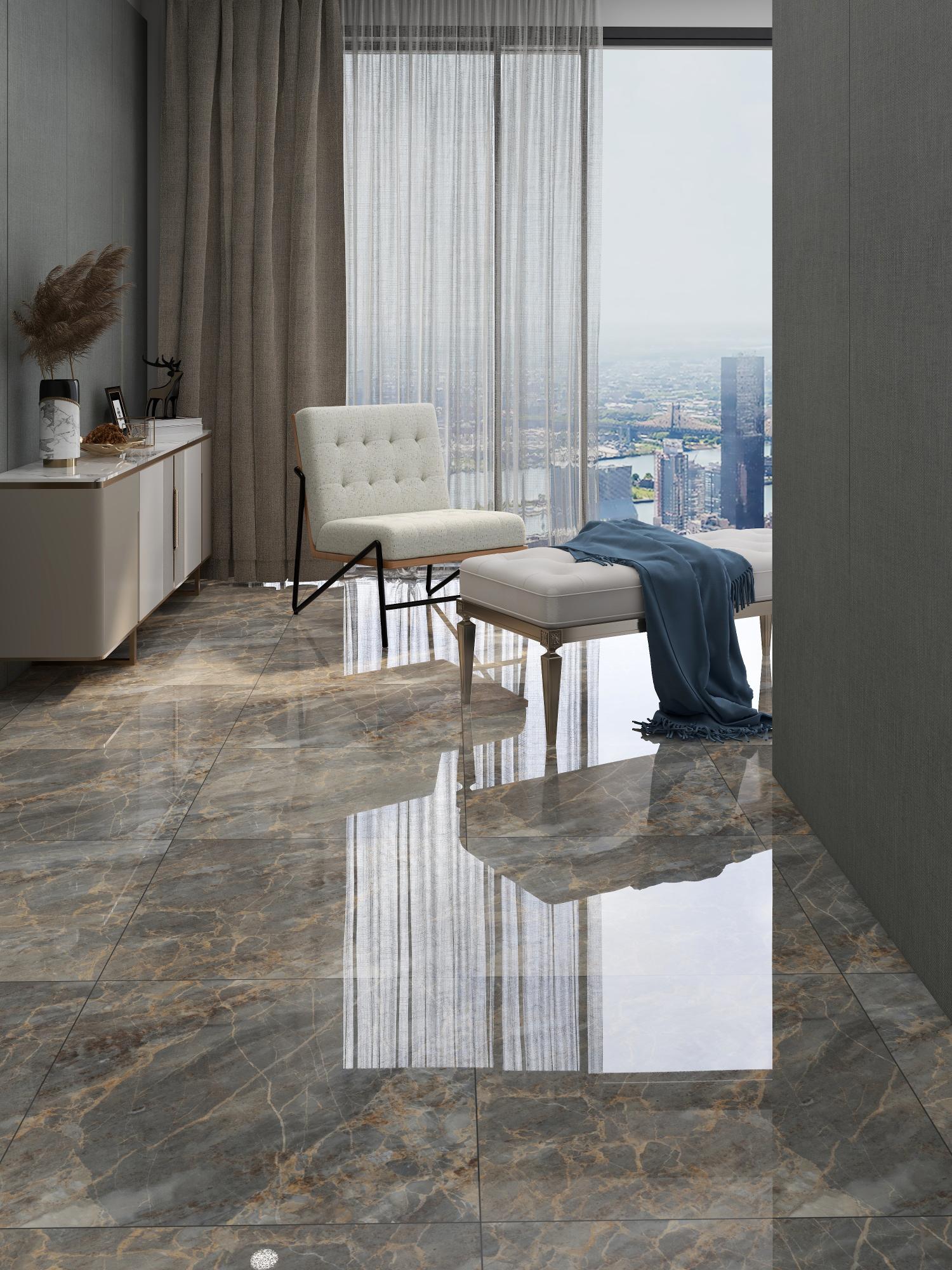
- Matte Finish: This finish is subtle and non-reflective, providing a sophisticated appearance with better slip resistance and can be ideal for wet areas. The below image is of a matte-finish porcelain floor in a bathroom.
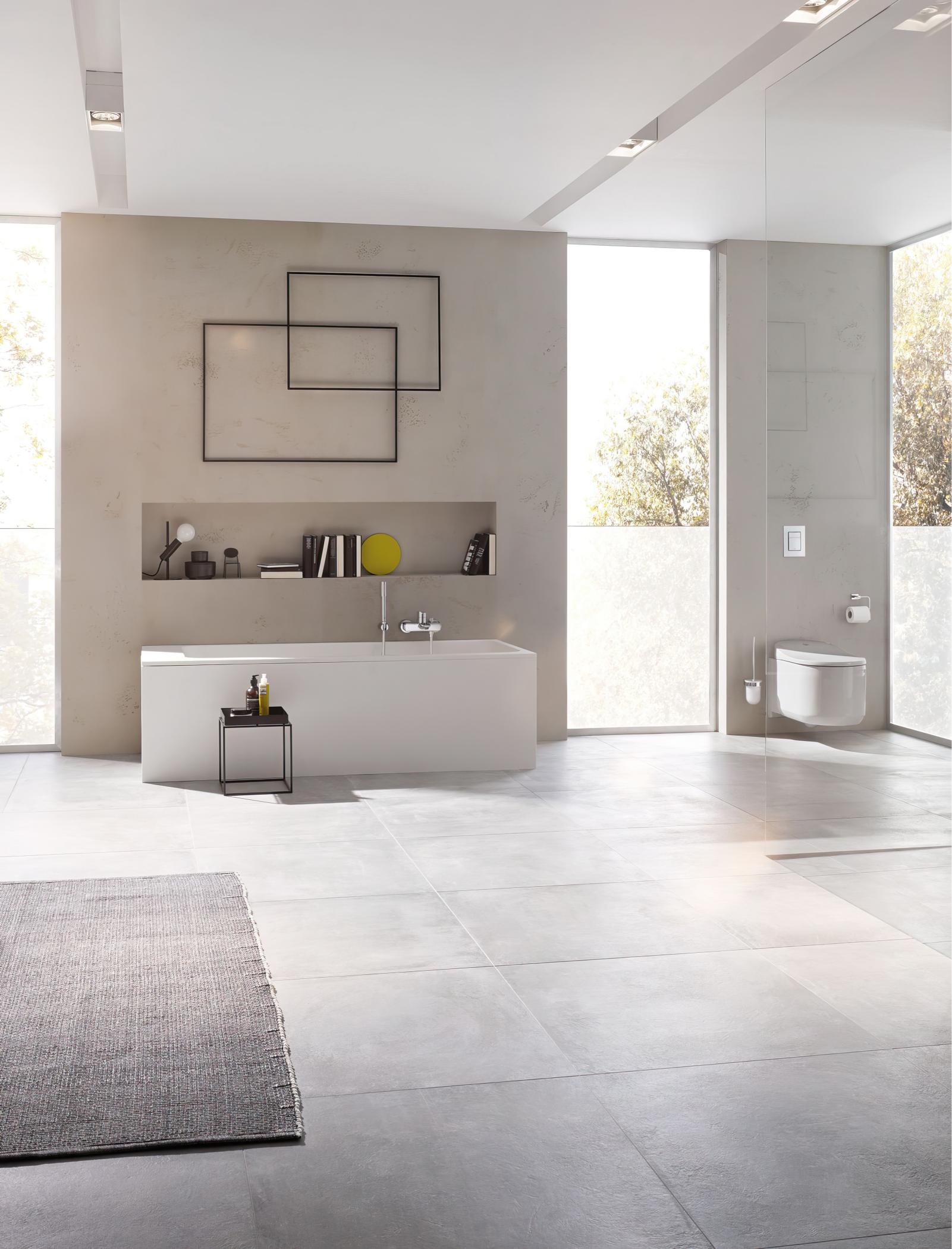
- Satin Finish: This finish gives a balance between matte and glossy, providing a soft sheen without being overly reflective. In the image below, you can observe a porcelain floor tile with a satin finish in a modern bathroom.
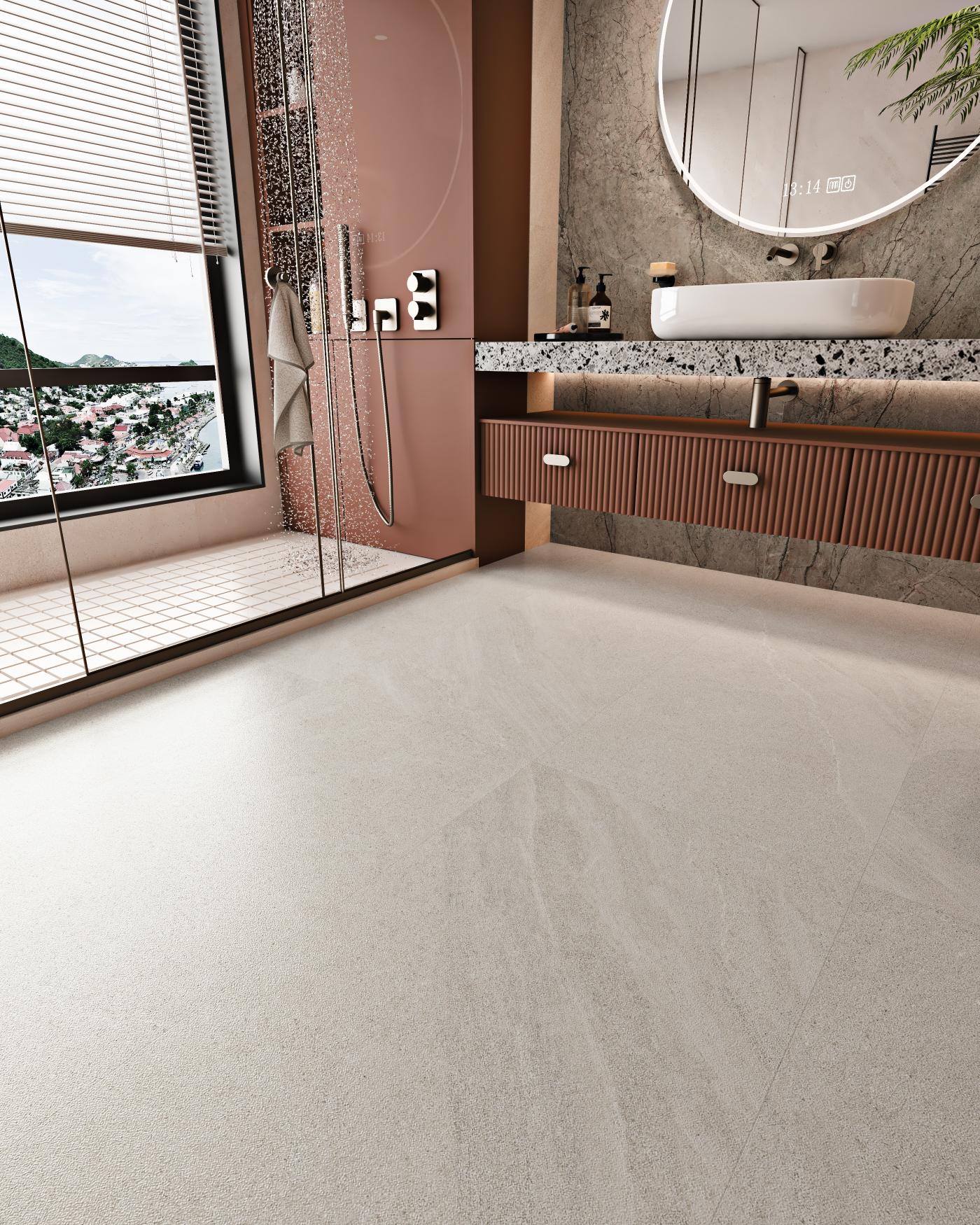
By Textures
These tiles come in various textures, adding depth and character to surfaces while also improving grip and usability.
- Wood-Look: This texture can mimic natural wood grains while offering better durability and water resistance. In the below image, you can see a wood-look, porcelain-floored bathroom.
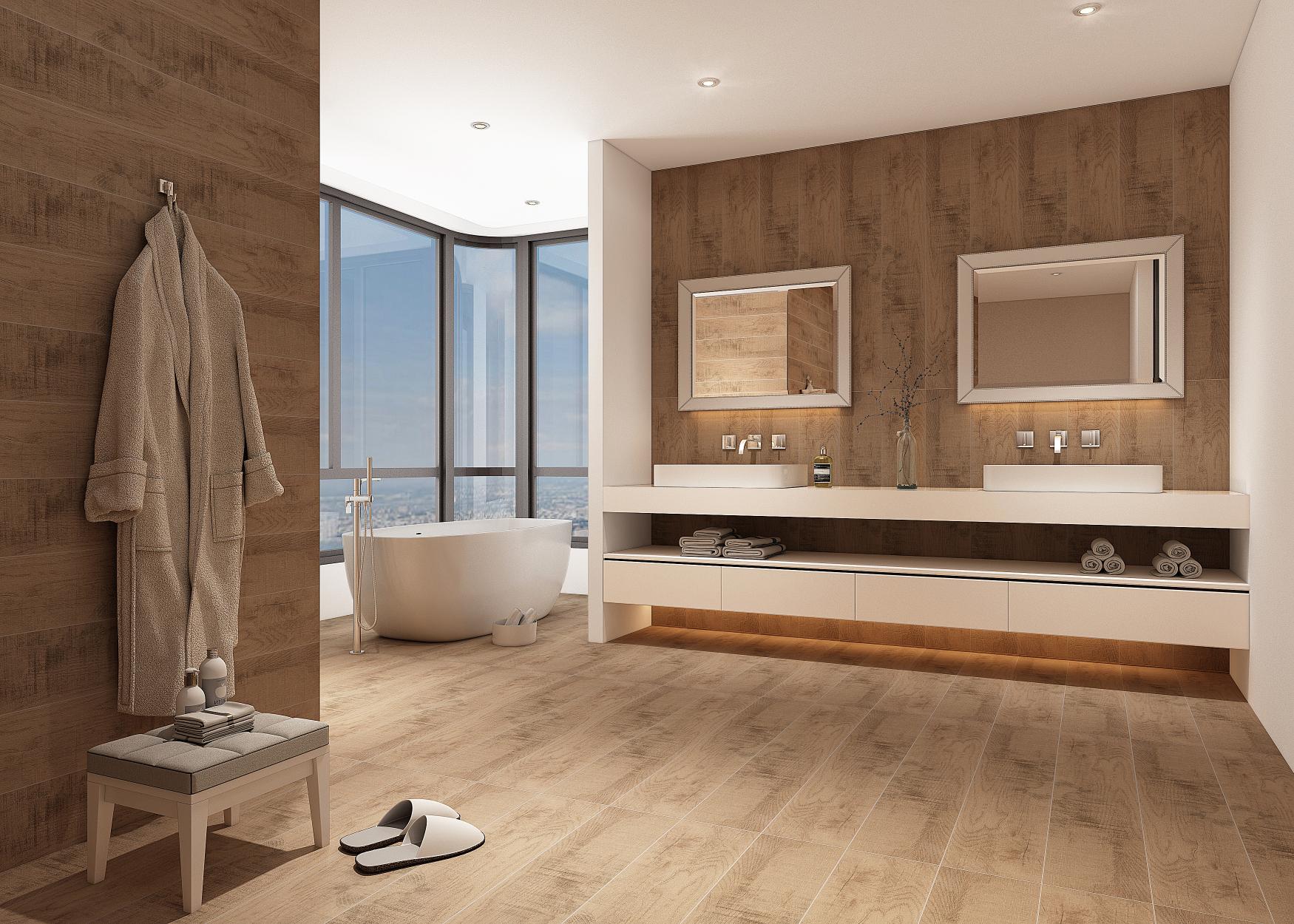
- Stone-Look: This texture can replicate the rugged texture of kota, limestone, or travertine and add a rustic or earthy appeal. In this image below is a stone-look porcelain floor area.
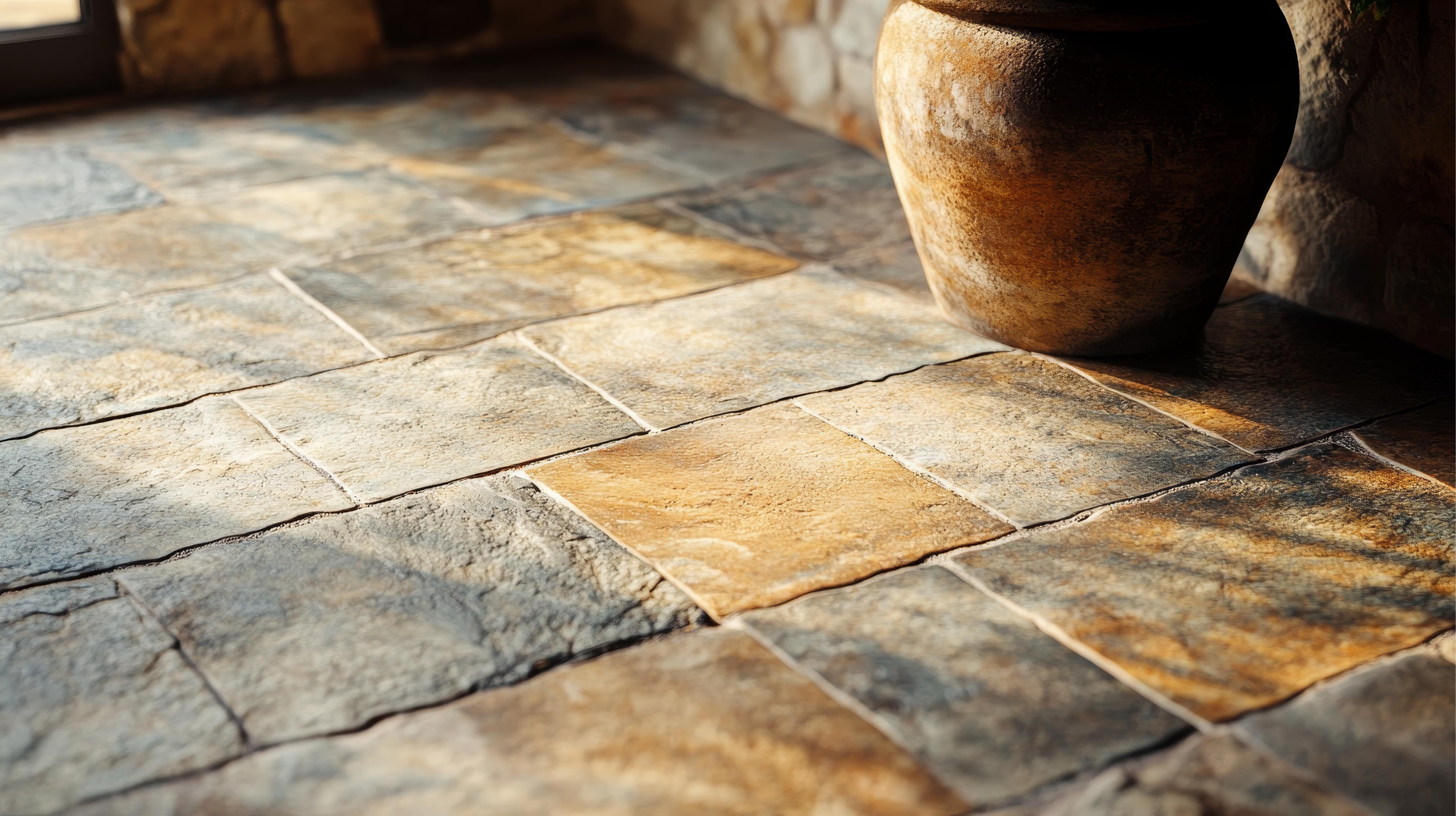
- Concrete-Look: This texture can be perfect for industrial and minimalist designs, offering an urban feel. In the picture below, you can see a concrete-look porcelain floor in a commercial open space.
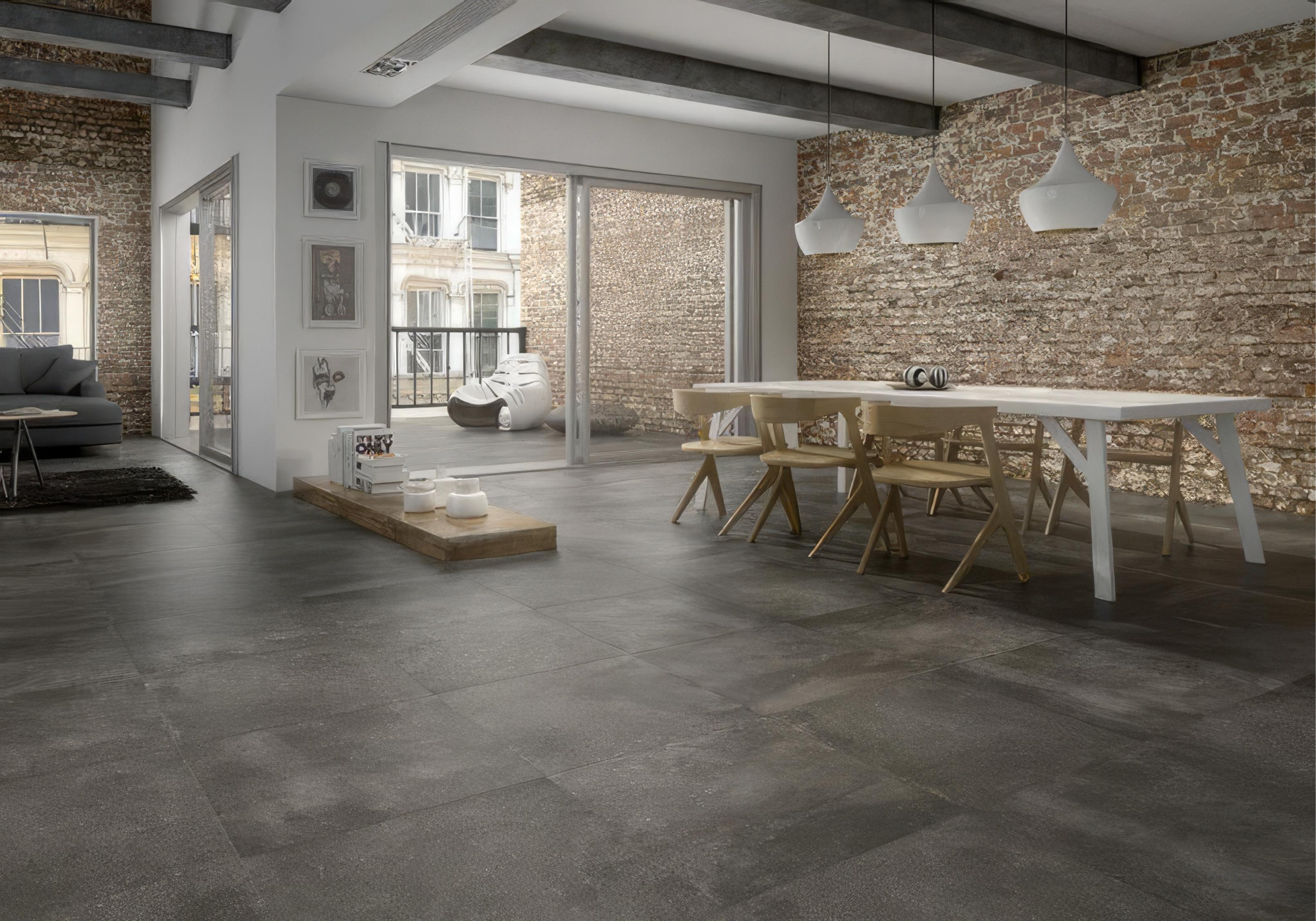
By Patterns & Layout
Beyond solid colors and textures, porcelain tiles come in various patterns and layouts that add personality to any space.
- Marble-Like: This texture can capture the luxurious veining of marble without the high maintenance. The below image shows a marble-look porcelain-floored living area.
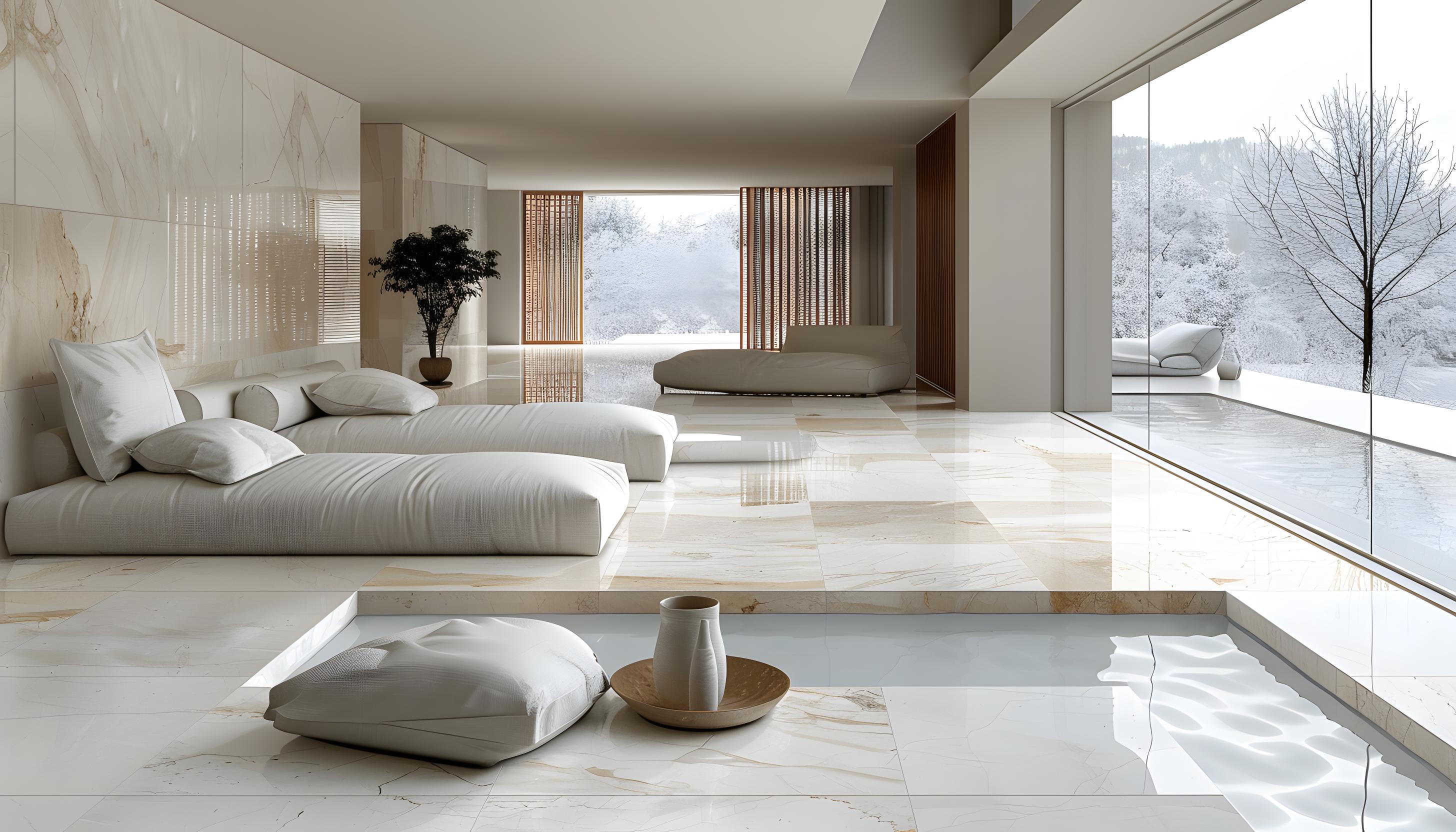
- Geometric Pattern: This pattern can be perfect for accent walls and ornamental flooring. This can bring visual interest by incorporating geometric shapes such as hexagons, squares, ovals, and more. The image below shows a geometrically patterned porcelain floor in a living room.
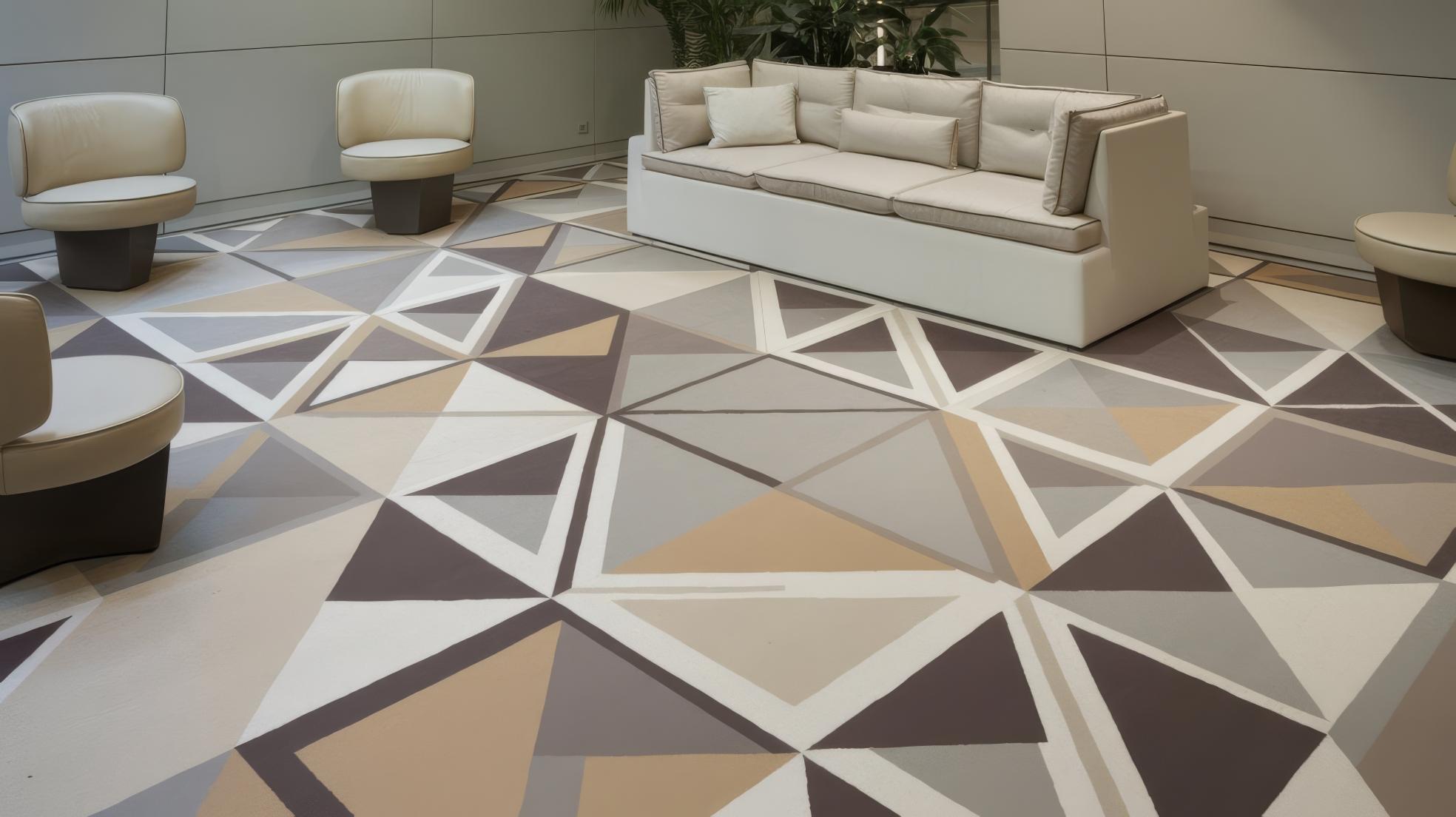
- Terrazzo Effect: This texture can feature a speckled pattern of traditional terrazzo, blending vintage charm with modernity. The below images showcase a beautiful bathroom floor with porcelain terrazzo effect tiles.
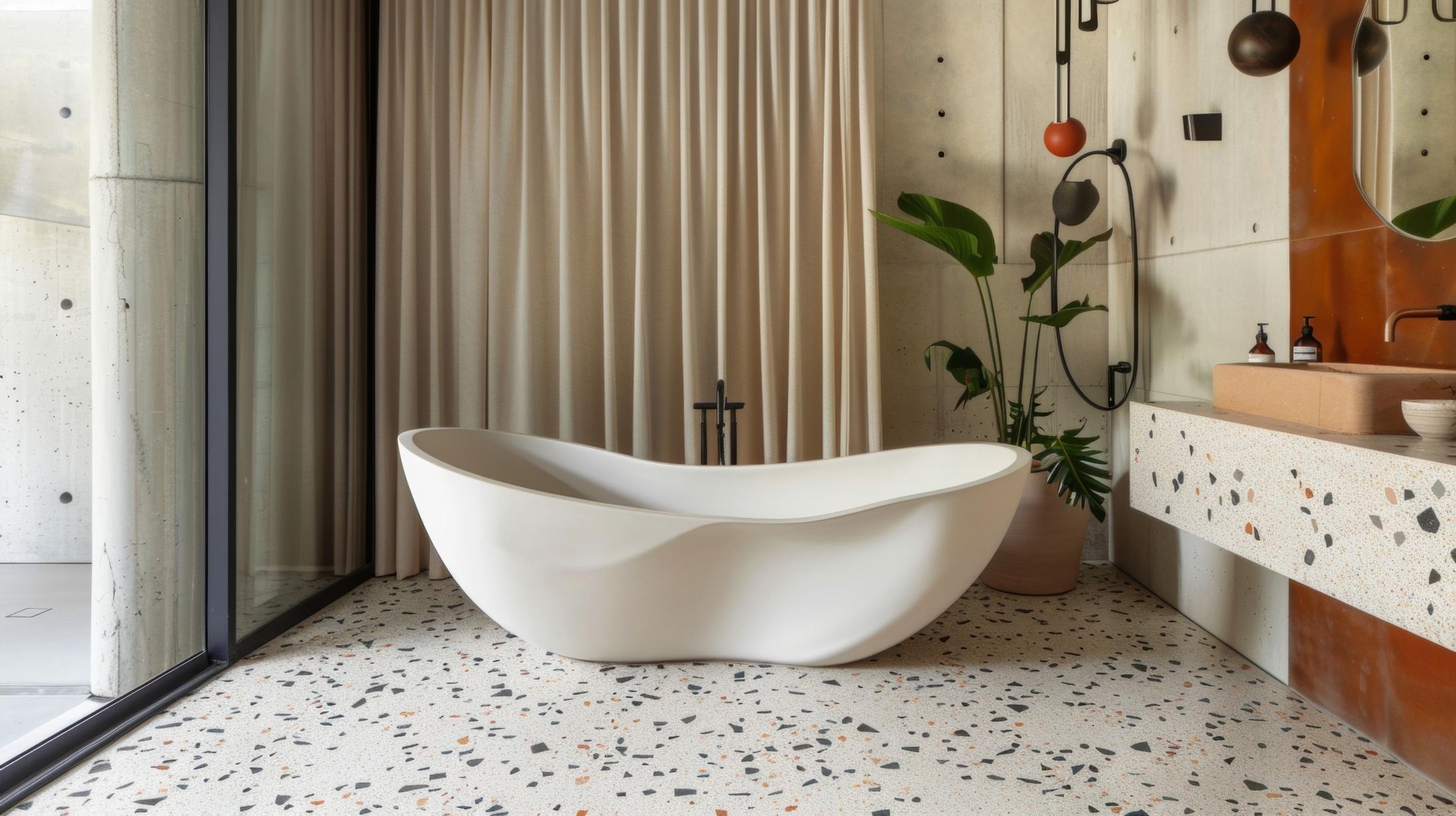
- Large-format tiles: This format can create a seamless, expansive look with fewer grout lines and is suitable for open spaces. In the image below, you can observe a large-format, glossy, porcelain-floored bathroom.
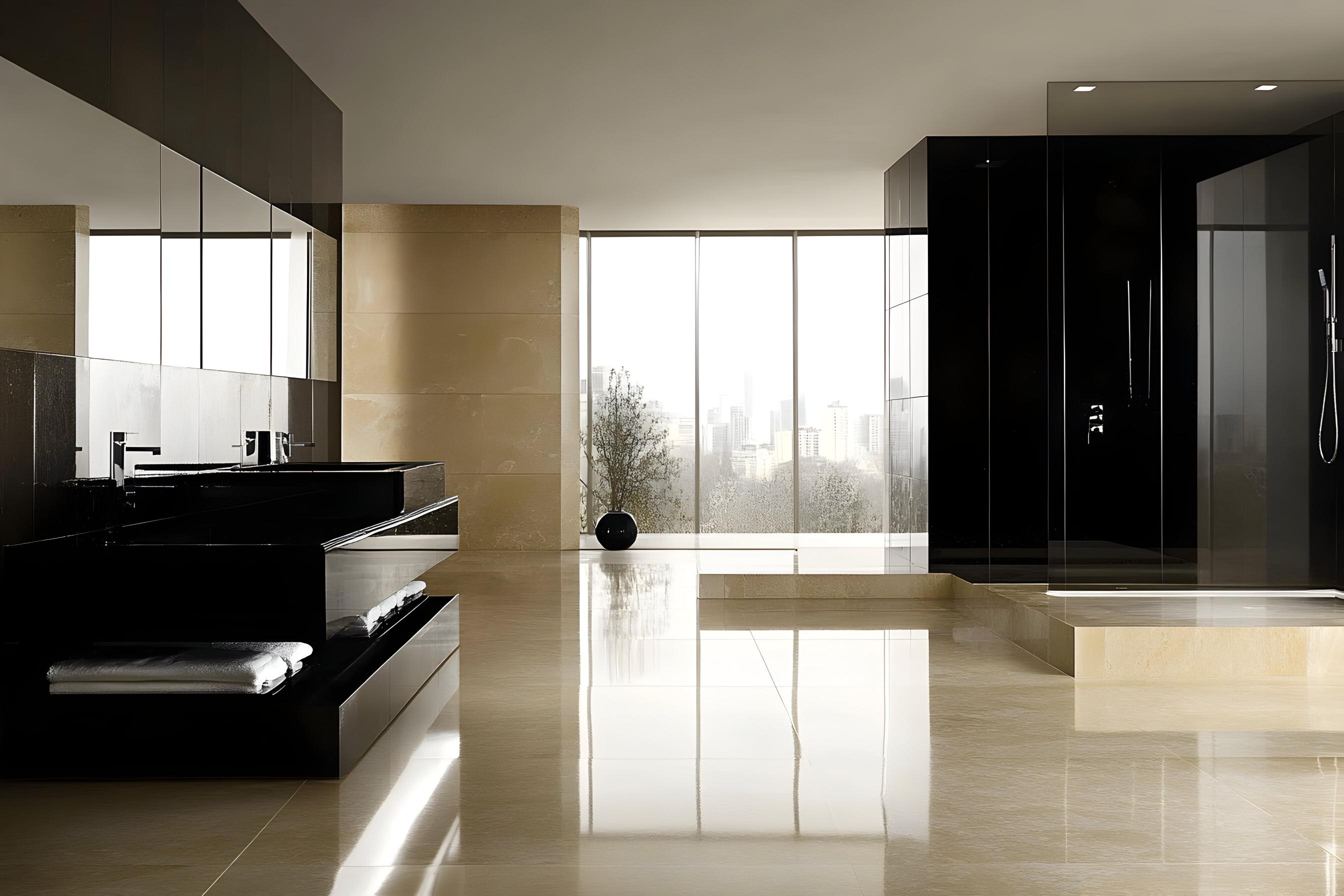
- Herringbone Pattern: Herringbone is a zigzag pattern where tiles are placed at an angled, interlocking design. This can add a sense of movement to a space. They can be popular for kitchens, bathrooms, and feature walls. In the below, you can observe herringbone-pattern walls and floors.
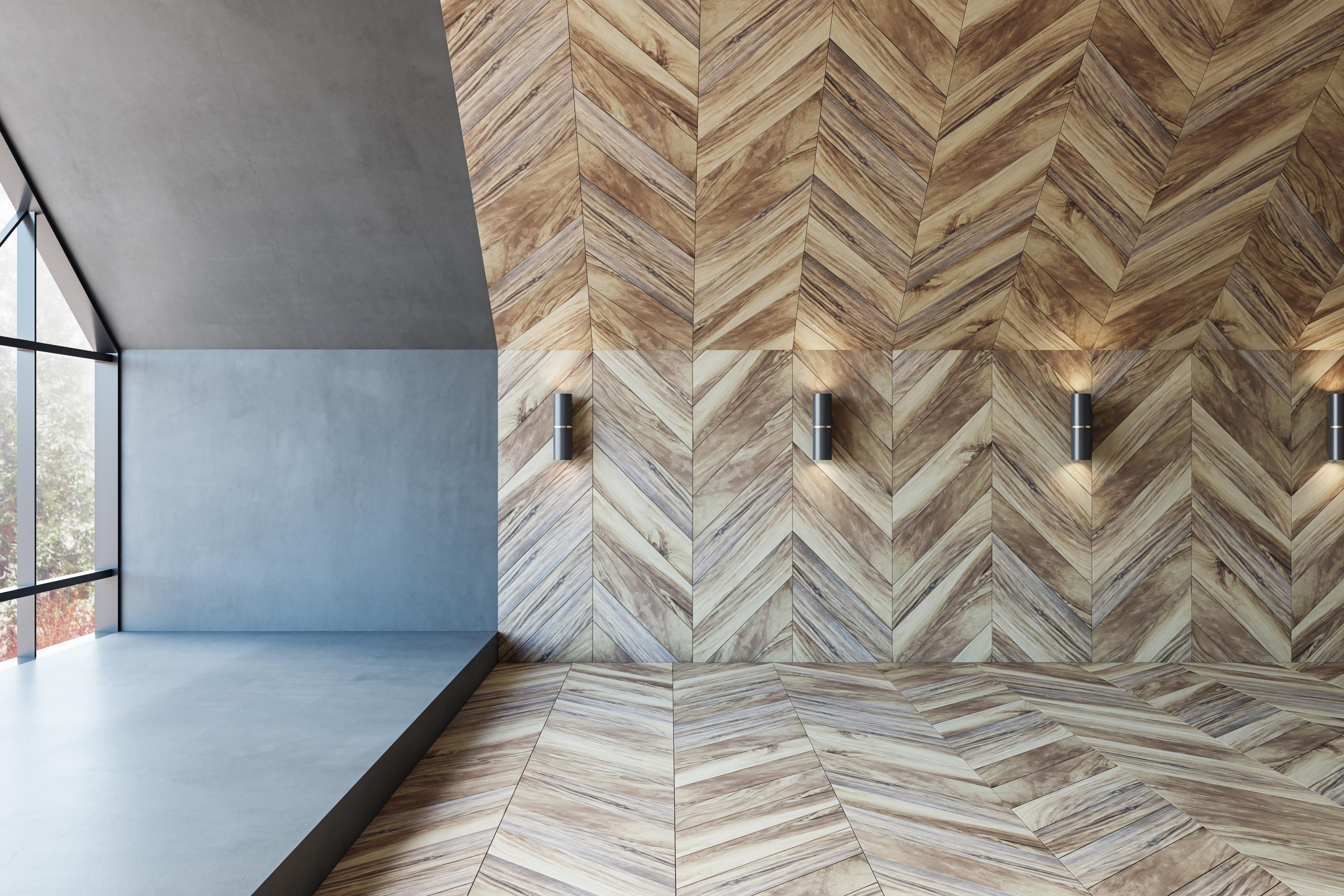
- Mosaic Pattern: Mosaic tiles are small, intricate tile designs arranged in unique patterns. They can be perfect for decorative accents, kitchen backsplashes, and artistic flooring. In the below image, you can see how beautiful porcelain mosaic flooring looks in outdoor areas.
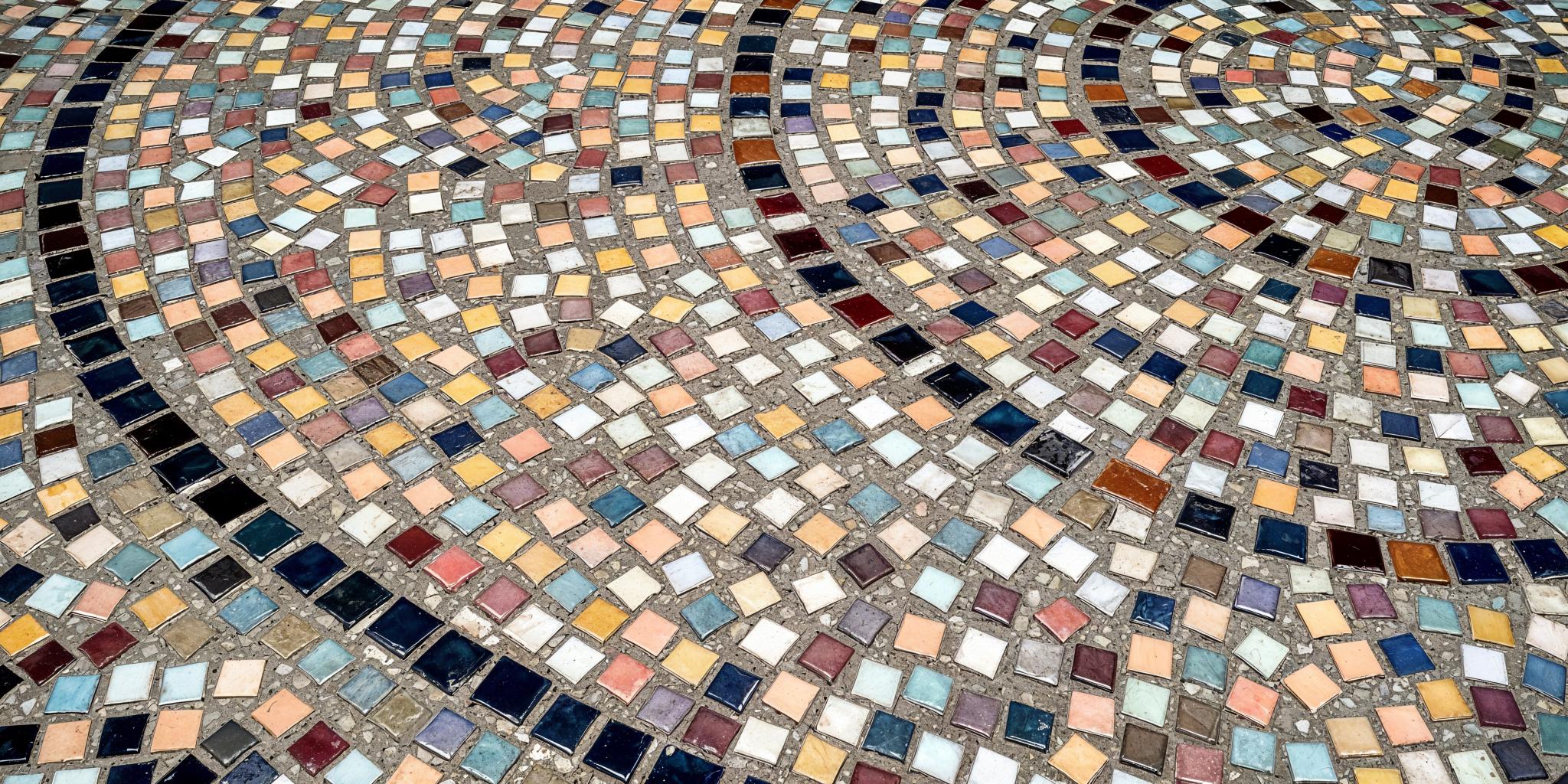
By Colors
Porcelain tiles are available in an extensive range of colors, allowing homeowners and designers to choose hues that complement their space.
- Neutral tones: Colors like beige, gray, and white porcelain are timeless and versatile, blending well with various interior styles. Below, you can observe a beige porcelain tile floor in the living area.
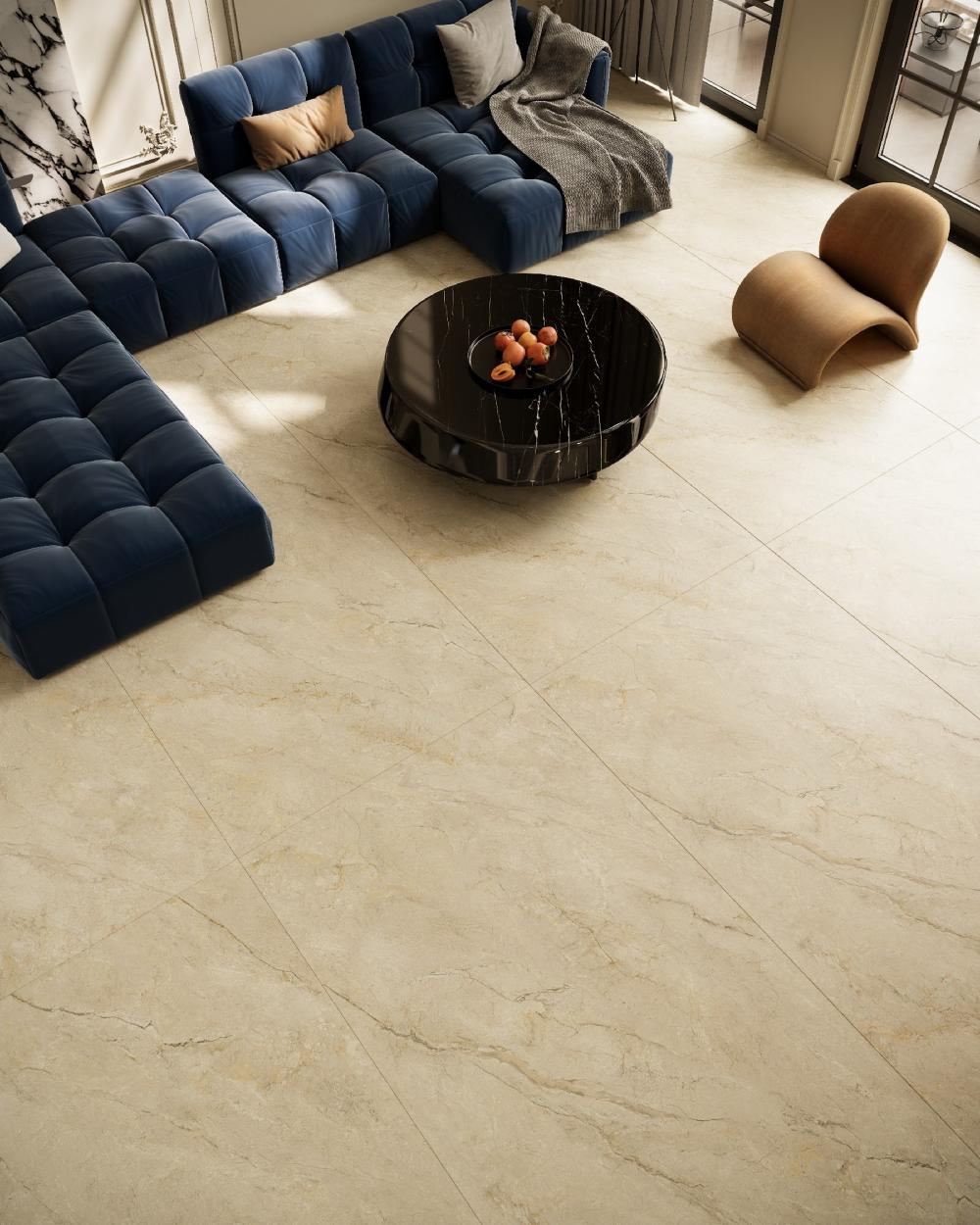
- Dark Shades: Shades like black, charcoal, or deep brown can add drama and sophistication. They are often used in contemporary or industrial designs. The below image is of hexagonal black tiles on the walls and floors of a bathroom.
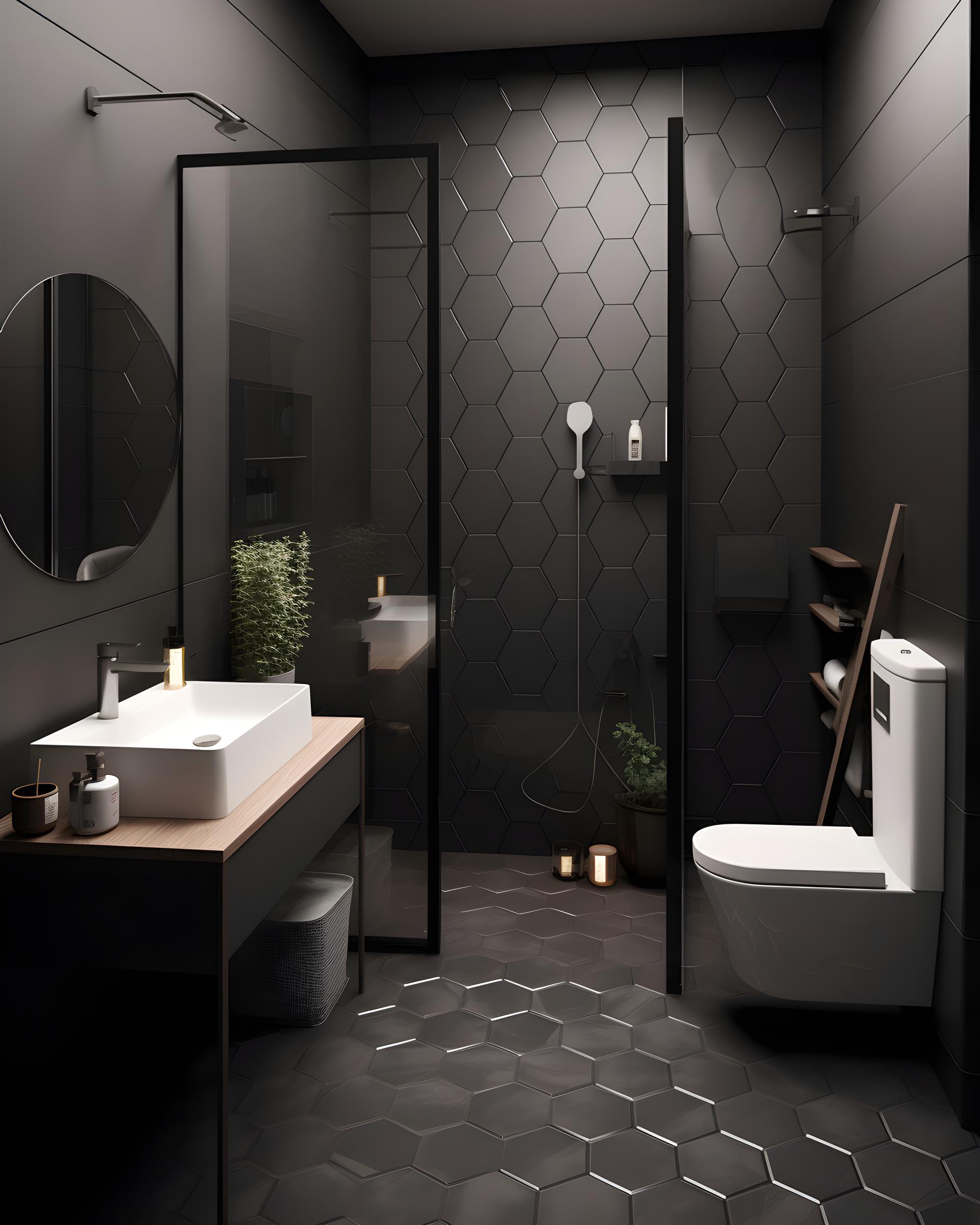
- Warm Hues: Warm colors like terracotta, sand, and gold can create a cozy, inviting ambiance. They are ideal for Mediterranean and rustic aesthetics. In the picture below, you can see terracotta floor tiles in a herringbone pattern for a living room area.
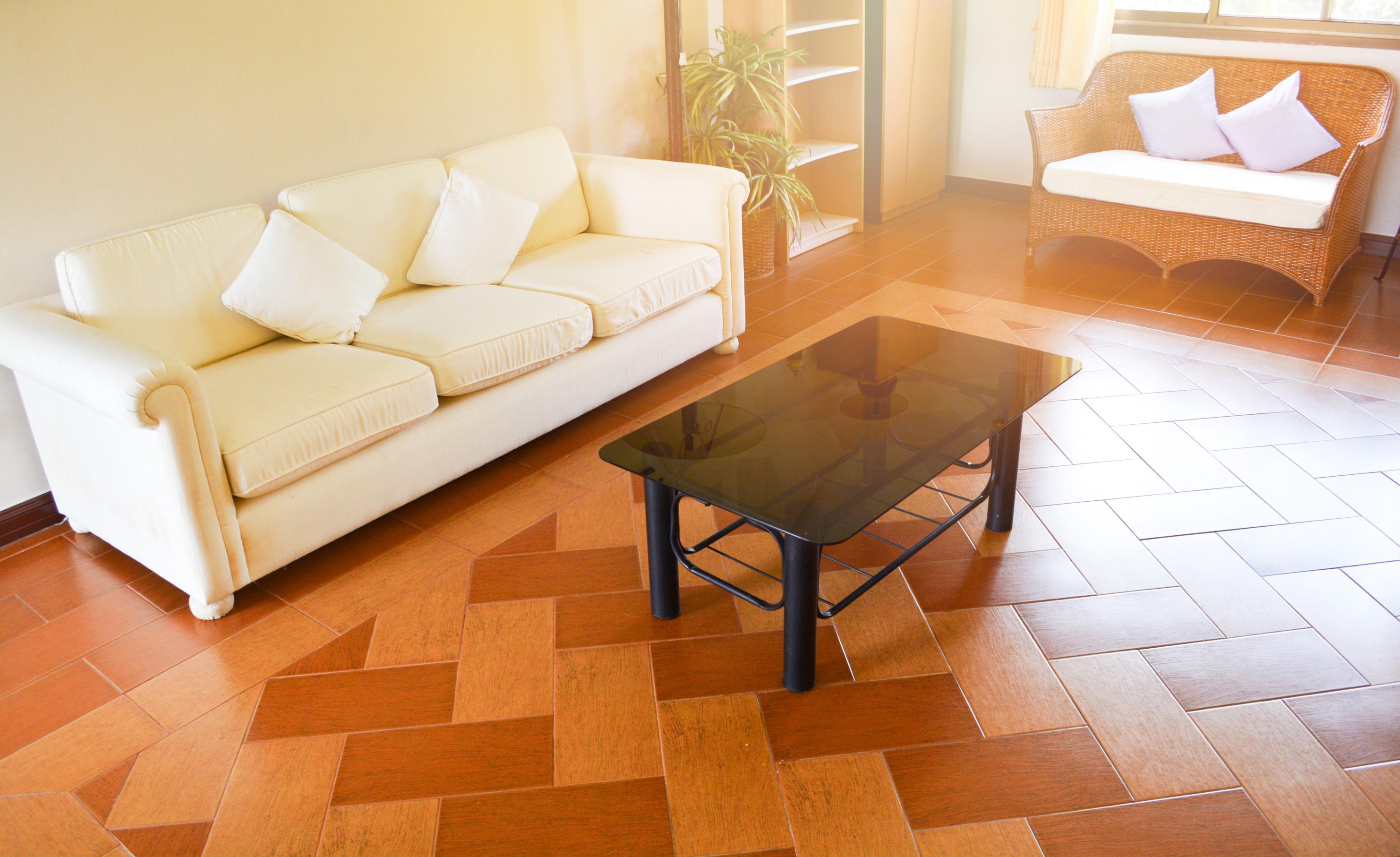
- Bold colors: Shades like blue, green, or burgundy are statement-making tiles that add personality and uniqueness to floors and walls. In the below image, you can see blue subway tiles on the bathroom wall and backsplash.
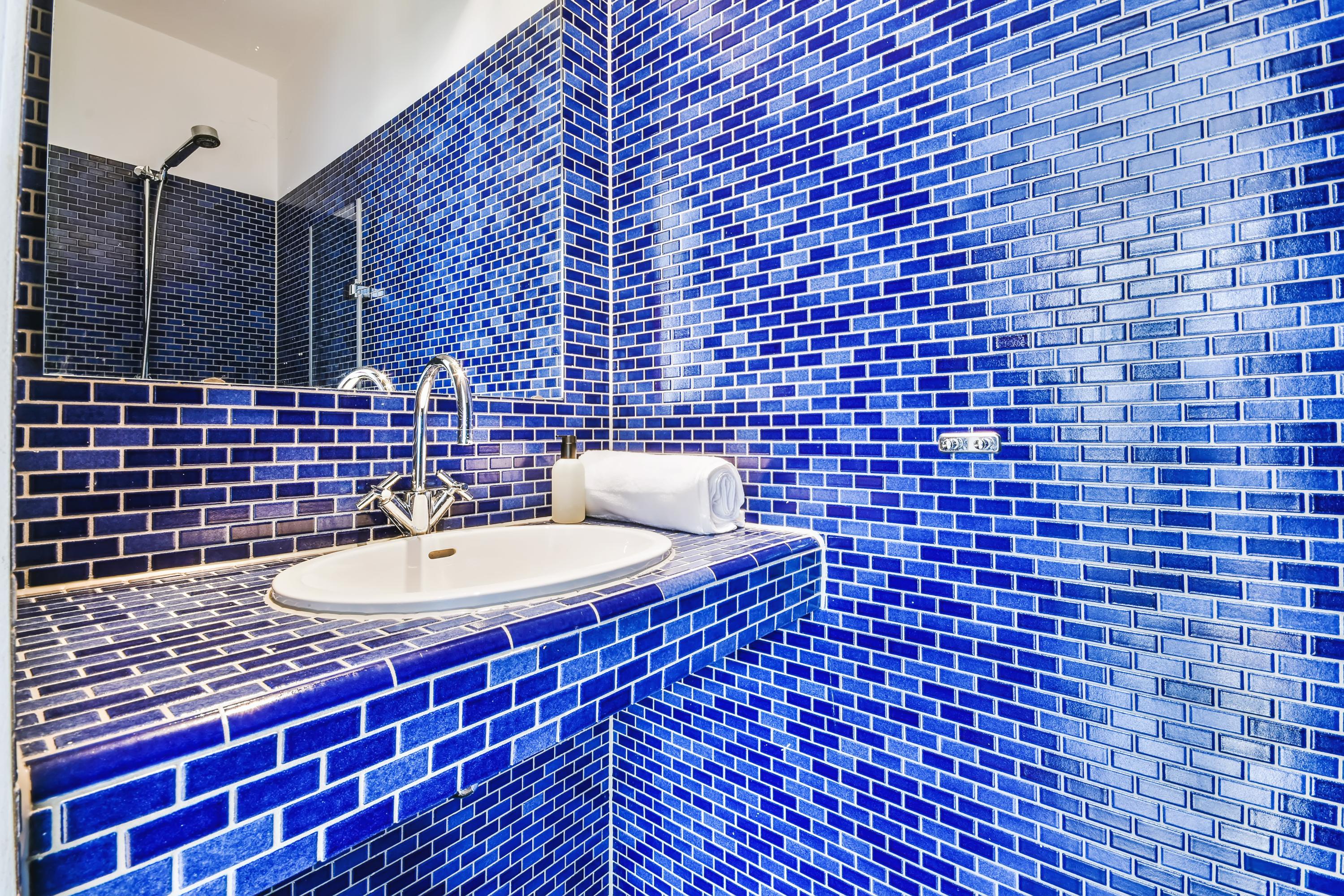
Best Uses of Porcelain Tiles
These tiles can be used in various spaces, be it indoors or outdoors. They can offer a balance of functionality and aesthetics.
- Porcelain Kitchen Tiles: These tiles can be a suitable choice for floors, backsplashes, and even countertops. Their waterproof and stain-resistant properties make cleaning easy. Kitchen floors can benefit from porcelain’s ability to withstand dropped utensils and constant movement. Backsplashes can protect walls from grease and moisture. Porcelain countertops can be the heat-resistant, low-maintenance choice.
- Porcelain Bathroom Tiles: These tiles in bathrooms can be the perfect non-porous, mold-resistant, and simple-to-clean choice. Slip-resistant finishes can add safety, while large-format tiles create a seamless, modern look. Porcelain can also be used for vanity backsplashes and shower enclosures without the risk of peeling or water damage.
- Porcelain Living Room Tiles: Porcelain tiles for living rooms are available in wood, marble, and stone-look designs. Wood-look porcelain tiles can provide warmth while being scratch-resistant. They can also be used for feature walls and fireplace surrounds, adding texture to the space while being heat-resistant and long-lasting.
- Porcelain Outdoor Tiles: These tiles, used in outdoor areas like patios, balconies, pool decks, and walkways, can be a top choice as they withstand weather changes, moisture, and wear. Their low porosity and slip-resistant finishes make them safe. Concrete-effect porcelain tiles can heighten the aesthetic appeal, while heavy-duty porcelain pavers can be used for driveways and pathways.
What is the Difference Between Porcelain and Ceramic Tiles?
Although porcelain and ceramic tiles look similar, they differ in composition, durability, and more.
Feature | Porcelain Tiles | Ceramic Tiles |
Composition | The product is made from refined, dense clay fired at high temperatures. | The product is made from less dense clay and is fired at lower temperatures. |
Durability | The material is highly durable. It resists scratches, stains, and heavy foot traffic. | Ceramic is less durable and more prone to chipping and wear over time. |
Water Resistance | The water absorption rate is <0.5%, which is ideal for moisture-prone areas. | They have higher water absorption, which is not ideal for wet areas. |
Best Applications | Porcelain works best for floors, bathrooms, kitchens, outdoor areas, and commercial spaces. | It works best for walls, backsplashes, and low-traffic indoor areas. |
Cost | They are pricier but longer-lasting. | It is more budget-friendly but less durable. |
Mytyles Bestsellers for Porcelain Tiles
Below are a few of the best-selling porcelain tiles at Mytyles:
- Porcelain Floor and Wall Tile Code 11342 (600x600mm, Glossy): These are suitable for both interior and exterior spaces with a glossy finish for a sleek look. These tiles are ideal for use in various areas such as living rooms, bedrooms, kitchens, offices, and more.
- Porcelain Floor and Wall Tile Code 23439 (600x600mm, Matt): This type of tile is suitable for residential and commercial spaces. They are simple to maintain and designed for medium foot traffic. They are ideal for various areas such as living rooms, bedrooms, kitchens, offices, and balconies.
- Porcelain Floor and Wall Tile Code 11369 (600x600mm, Matt): This black tile, featuring an 8mm thickness for durability, offers a sleek, modern look for any space. They can suit living rooms, bedrooms, kitchens, offices, balconies, bathrooms, and even parking areas.
- Porcelain Wooden Tile Code 24740 (600x600mm, Matt): This porcelain tile features an 8mm thickness and a matte finish wood look for a refined touch. It is easy to maintain, and it is designed for medium-foot traffic in both indoor and outdoor settings.
- Porcelain Moroccan Tile Code 24731 (600x600mm, Matt): This tile in blue brings a touch of elegance with its intricate patterns, perfect for enhancing both floors and walls. This premium tile adds a unique aesthetic in living rooms, bedrooms, kitchens, offices, balconies, and more.
A Final Look at Porcelain Tiles
Porcelain can offer unmatched durability, water resistance, and design for any space. While they require professional installation and a higher initial investment, their longevity and minimal maintenance can provide excellent long-term value. Whether for indoor or outdoor spaces, porcelain can deliver reliable performance without sacrificing style. You can consider your specific needs for moisture exposure and aesthetics when selecting the perfect porcelain tiles. For more information on transforming your space with various porcelain tile collections, visit the MyTyles website or our experience center.
FAQs on Porcelain Tiles
Q. What is porcelain tile made of?
Ans. Porcelain tiles are made from a dense ceramic material composed of clay, feldspar, and quartz, fired at high temperatures to achieve durability and water resistance.
Q. How do I clean porcelain tiles?
Ans. Clean porcelain tiles using a mild detergent and warm water. Avoid abrasive cleaners or scrubbers to prevent damage.
Q. Are porcelain tiles waterproof?
Ans. Porcelain tiles are highly water-resistant due to their low porosity, but they are not completely waterproof. Grout lines can still absorb water.
Q. How do I install porcelain tiles?
Ans. Install porcelain tiles by preparing a level and clean subfloor, using a suitable adhesive, and following the manufacturer's instructions for spacing and drying times.
Q. What is the difference between porcelain and ceramic tiles?
Ans. Porcelain tiles are denser and less porous than ceramic tiles, offering greater durability and water resistance, making them suitable for high-traffic areas and wet environments.
Q. Can porcelain tiles be used outdoors?
Ans. If specifically designed for outdoor use, porcelain tiles can withstand weather conditions and UV exposure.
Q. How durable are porcelain tiles?
Ans. Porcelain tiles are very durable and resistant to scratches and wear, making them ideal for high-traffic areas.
Q. Do porcelain tiles require sealing?
Ans. Generally, porcelain tiles do not require sealing due to their low porosity. However, the grout lines may need sealing to prevent water absorption.
Q. Can porcelain tiles be used in bathrooms and kitchens?
Ans. Yes, porcelain tiles are well-suited for bathrooms and kitchens due to their water resistance and ease of cleaning.
Q. Are porcelain tiles pricier than ceramic tiles?
Ans. Yes, porcelain tiles are generally pricier than ceramic tiles due to their higher quality and durability. However, they offer long-term benefits in terms of maintenance and lifespan.
